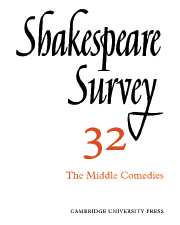Book contents
- Frontmatter
- Shakespeare’s Middle Comedies: A Generation of Criticism
- ‘Perfect Types of Womanhood’: Rosalind, Beatrice and Viola in Victorian Criticism and Performance
- The Stage Representation of the ‘Kill Claudio’ Sequence in Much Ado About Nothing
- As You Like It Adapted: Charles Johnson’s Love in a Forest
- Social Relations and the Social Order in Much Ado About Nothing
- Sexual Disguise in As You Like It and Twelfth Night
- Twelfth Night and the Myth of Echo and Narcissus
- ‘Smiling at grief’: Some Techniques of Comedy in Twelfth Night and Così Fan Tutte
- ‘My Lady’s a Catayan, we are politicians, Maluolios a Peg-a-ramsie’ (Twelfth Night II, iii, 77-8)
- The Importance of Being Marcade
- A Hebrew Source for The Merchant of Venice
- The Marriage Contracts in Measure for Measure: A Reconsideration
- Richard III: Antecedents of Clarence’s Dream
- Deep Plots and Indiscretions in ‘The Murder of Gonzago’
- ‘What is’t to leave betimes?’ Proverbs and Logic in Hamlet
- The Tempest: Language and Society
- Pictorial Evidence for a Possible Replica of the London Fortune Theatre in Gdansk
- A Year of Comedies: Stratford 1978
- The Year's Contributions to Shakespearian Study: 1 Critical Studies
- 2 Shakespeare’s Life, Times and Stage
- 3 Textual Studies
- Index
- Plate section
‘What is’t to leave betimes?’ Proverbs and Logic in Hamlet
Published online by Cambridge University Press: 28 March 2007
- Frontmatter
- Shakespeare’s Middle Comedies: A Generation of Criticism
- ‘Perfect Types of Womanhood’: Rosalind, Beatrice and Viola in Victorian Criticism and Performance
- The Stage Representation of the ‘Kill Claudio’ Sequence in Much Ado About Nothing
- As You Like It Adapted: Charles Johnson’s Love in a Forest
- Social Relations and the Social Order in Much Ado About Nothing
- Sexual Disguise in As You Like It and Twelfth Night
- Twelfth Night and the Myth of Echo and Narcissus
- ‘Smiling at grief’: Some Techniques of Comedy in Twelfth Night and Così Fan Tutte
- ‘My Lady’s a Catayan, we are politicians, Maluolios a Peg-a-ramsie’ (Twelfth Night II, iii, 77-8)
- The Importance of Being Marcade
- A Hebrew Source for The Merchant of Venice
- The Marriage Contracts in Measure for Measure: A Reconsideration
- Richard III: Antecedents of Clarence’s Dream
- Deep Plots and Indiscretions in ‘The Murder of Gonzago’
- ‘What is’t to leave betimes?’ Proverbs and Logic in Hamlet
- The Tempest: Language and Society
- Pictorial Evidence for a Possible Replica of the London Fortune Theatre in Gdansk
- A Year of Comedies: Stratford 1978
- The Year's Contributions to Shakespearian Study: 1 Critical Studies
- 2 Shakespeare’s Life, Times and Stage
- 3 Textual Studies
- Index
- Plate section
Summary
When he created Denmark’s corrupt court, Shakespeare played fast and loose with common sixteenth-century adages which then formed the great bulk of moral philosophy. At the same time he skillfully mishandled the rules of logic then commonly used to prove the dicta of proverbial wisdom. Shakespeare did so, I think, in the confidence that his audience which was taught from childhood to speak in proverbs and act on precepts would recognize his distortions and judge accordingly. Erasmus’s Adagia, of course, was the great source for Renaissance collections of proverbs. It was thus also the principal textbook of moral philosophy, which William Baldwin defined as ‘the knowledge of precepts of al honest maners . . . necessary for the comely gouernaunce of mans lyfe’. Furthermore, said Baldwin, ‘it is the duetye of . . . Logike, to make reasons to proue and improue . . . Ethike, which is moral Philosophye’ (f. 2). In Hamlet, Shakespeare sometimes manipulated the proverbs of moral Philosophye’ (fo. 2). In Hamlet, Shakespeare cipate discoveries. More often, however, Shakespeare made the characters clustered about Claudius and Claudius himself define their being and their actions in terms of proverbs which are false either because they are somehow garbled or because they reflect moral values which clearly no longer obtain in Elsinore.
- Type
- Chapter
- Information
- Shakespeare Survey , pp. 163 - 176Publisher: Cambridge University PressPrint publication year: 1980



